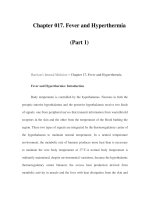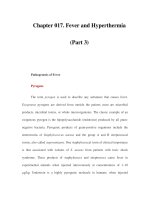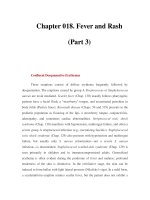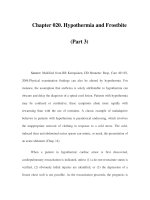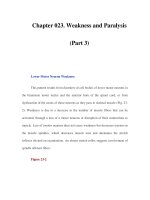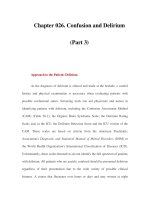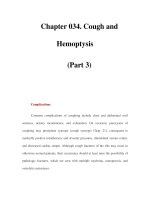Chapter 046. Sodium and Water (Part 3) docx
Bạn đang xem bản rút gọn của tài liệu. Xem và tải ngay bản đầy đủ của tài liệu tại đây (12.85 KB, 5 trang )
Chapter 046. Sodium and Water
(Part 3)
Hypovolemia
Etiology
True volume depletion, or hypovolemia, generally refers to a state of
combined salt and water loss exceeding intake, leading to ECF volume
contraction. The loss of Na
+
may be renal or extrarenal (Table 46-1).
Table 46-1 Causes of Hypovolemia
I. ECF volume contracted
A. Extrarenal Na
+
loss
1. Gastrointestinal (vomiting, nasogastric suction,
drainage, fistula, diarrhea)
2. Skin/respiratory (insensible losses, sweat, burns)
3. Hemorrhage
B. Renal Na
+
and water loss
1. Diuretics
2. Osmotic diuresis
3. Hypoaldosteronism
4. Salt-wasting nephropathies
C. Renal water loss
1. Diabetes insipidus (central or nephrogenic)
II. ECF volume normal or expanded
A. Decreased cardiac output
1. Myocardial, valvular, or pericardial disease
B. Redistribution
1. Hypoalbuminemia (hepatic cirrhosis, nephrotic
syndrome)
2. Capillary leak (acute pancreatitis, ischemic
bowel, rhabdomyolysis)
C. Increased venous capacitance
1. Sepsis
Note: ECF, extracellular fluid.
Renal
Many conditions are associated with excessive urinary NaCl and water
losses, including diuretics. Pharmacologic diuretics inhibit specific pathways of
Na
+
reabsorption along the nephron with a consequent increase in urinary Na
+
excretion. Enhanced filtration of non-reabsorbed solutes, such as glucose or urea,
can also impair tubular reabsorption of Na
+
and water, leading to an osmotic or
solute diuresis. This often occurs in poorly controlled diabetes mellitus and in
patients receiving high-protein hyperalimentation. Mannitol is a diuretic that
produces an osmotic diuresis because the renal tubule is impermeable to mannitol.
Many tubule and interstitial renal disorders are associated with Na
+
wasting.
Excessive renal losses of Na
+
and water may also occur during the diuretic phase
of acute tubular necrosis (Chap. 273) and following the relief of bilateral urinary
tract obstruction. Finally, mineralocorticoid deficiency (hypoaldosteronism)
causes salt wasting in the presence of normal intrinsic renal function.
Massive renal water excretion can also lead to hypovolemia. The ECF
volume contraction is usually less severe since two-thirds of the volume lost is
intracellular. Conditions associated with excessive urinary water loss include
central diabetes insipidus (CDI) and nephrogenic diabetes insipidus (NDI). These
two disorders are due to impaired secretion of and renal unresponsiveness to AVP,
respectively, and are discussed below.
